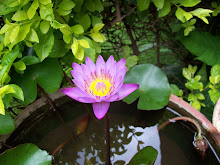
 When you drive through the hills of the Western Ghats, you come across this fern clinging to some trees. This is the Drynaria quercifolia, a fern with sterile fronds, like the Staghorn fern. The locals say that this fern eventually kills its host tree. It is called Kage Rekke in Kannada, which means Crow's Wings. Whether there is truth in the fears of the locals or not, this fern is a beauty.
When you drive through the hills of the Western Ghats, you come across this fern clinging to some trees. This is the Drynaria quercifolia, a fern with sterile fronds, like the Staghorn fern. The locals say that this fern eventually kills its host tree. It is called Kage Rekke in Kannada, which means Crow's Wings. Whether there is truth in the fears of the locals or not, this fern is a beauty.It has many medicinal uses too. Its leaves are used to alleviate fever and cough. It is also used to treat dyspepsia.



























